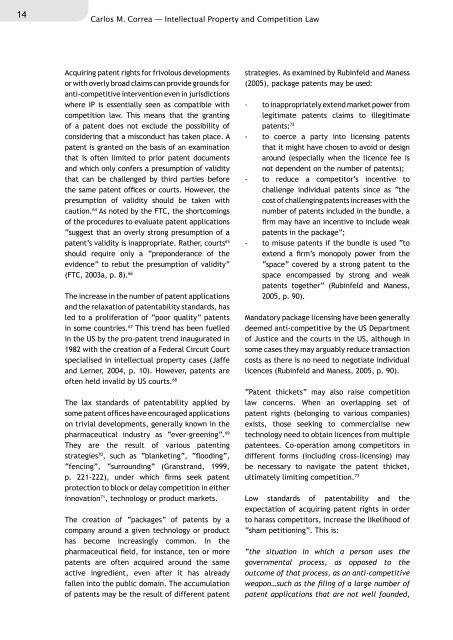Intellectual Property and Competition Law - IPRsonline.org
Intellectual Property and Competition Law - IPRsonline.org
Intellectual Property and Competition Law - IPRsonline.org
Create successful ePaper yourself
Turn your PDF publications into a flip-book with our unique Google optimized e-Paper software.
14Carlos M. Correa — <strong>Intellectual</strong> <strong>Property</strong> <strong>and</strong> <strong>Competition</strong> <strong>Law</strong>Acquiring patent rights for frivolous developmentsor with overly broad claims can provide grounds foranti-competitive intervention even in jurisdictionswhere IP is essentially seen as compatible withcompetition law. This means that the grantingof a patent does not exclude the possibility ofconsidering that a misconduct has taken place. Apatent is granted on the basis of an examinationthat is often limited to prior patent documents<strong>and</strong> which only confers a presumption of validitythat can be challenged by third parties beforethe same patent offices or courts. However, thepresumption of validity should be taken withcaution. 64 As noted by the FTC, the shortcomingsof the procedures to evaluate patent applications“suggest that an overly strong presumption of apatent’s validity is inappropriate. Rather, courts 65should require only a “preponderance of theevidence” to rebut the presumption of validity”(FTC, 2003a, p. 8). 66The increase in the number of patent applications<strong>and</strong> the relaxation of patentability st<strong>and</strong>ards, hasled to a proliferation of “poor quality” patentsin some countries. 67 This trend has been fuelledin the US by the pro-patent trend inaugurated in1982 with the creation of a Federal Circuit Courtspecialised in intellectual property cases (Jaffe<strong>and</strong> Lerner, 2004, p. 10). However, patents areoften held invalid by US courts. 68The lax st<strong>and</strong>ards of patentability applied bysome patent offices have encouraged applicationson trivial developments, generally known in thepharmaceutical industry as “ever-greening”. 69They are the result of various patentingstrategies 70 , such as “blanketing”, “flooding”,“fencing”, “surrounding” (Granstr<strong>and</strong>, 1999,p. 221-222), under which firms seek patentprotection to block or delay competition in eitherinnovation 71 , technology or product markets.The creation of “packages” of patents by acompany around a given technology or producthas become increasingly common. In thepharmaceutical field, for instance, ten or morepatents are often acquired around the sameactive ingredient, even after it has alreadyfallen into the public domain. The accumulationof patents may be the result of different patentstrategies. As examined by Rubinfeld <strong>and</strong> Maness(2005), package patents may be used:- to inappropriately extend market power fromlegitimate patents claims to illegitimatepatents; 72- to coerce a party into licensing patentsthat it might have chosen to avoid or designaround (especially when the licence fee isnot dependent on the number of patents);- to reduce a competitor’s incentive tochallenge individual patents since as “thecost of challenging patents increases with thenumber of patents included in the bundle, afirm may have an incentive to include weakpatents in the package”;- to misuse patents if the bundle is used “toextend a firm’s monopoly power from the“space” covered by a strong patent to thespace encompassed by strong <strong>and</strong> weakpatents together” (Rubinfeld <strong>and</strong> Maness,2005, p. 90).M<strong>and</strong>atory package licensing have been generallydeemed anti-competitive by the US Departmentof Justice <strong>and</strong> the courts in the US, although insome cases they may arguably reduce transactioncosts as there is no need to negotiate individuallicences (Rubinfeld <strong>and</strong> Maness, 2005, p. 90).“Patent thickets” may also raise competitionlaw concerns. When an overlapping set ofpatent rights (belonging to various companies)exists, those seeking to commercialise newtechnology need to obtain licences from multiplepatentees. Co-operation among competitors indifferent forms (including cross-licensing) maybe necessary to navigate the patent thicket,ultimately limiting competition. 73Low st<strong>and</strong>ards of patentability <strong>and</strong> theexpectation of acquiring patent rights in orderto harass competitors, increase the likelihood of“sham petitioning”. This is:“the situation in which a person uses thegovernmental process, as opposed to theoutcome of that process, as an anti-competitiveweapon…such as the filing of a large number ofpatent applications that are not well founded,









